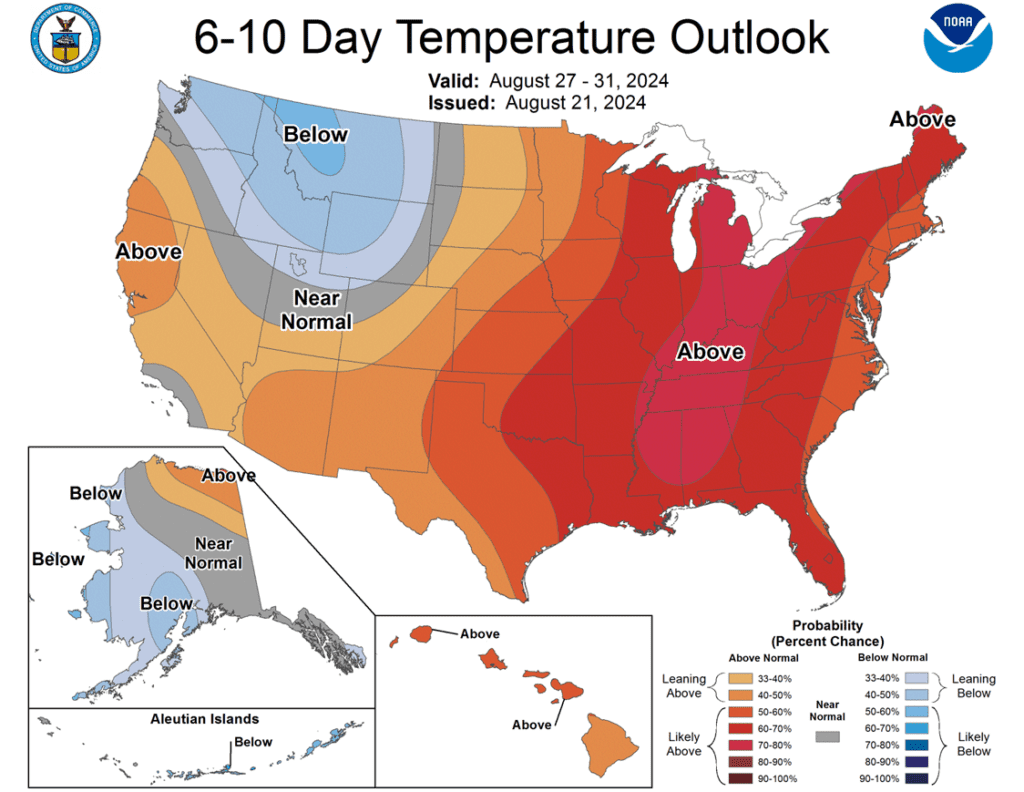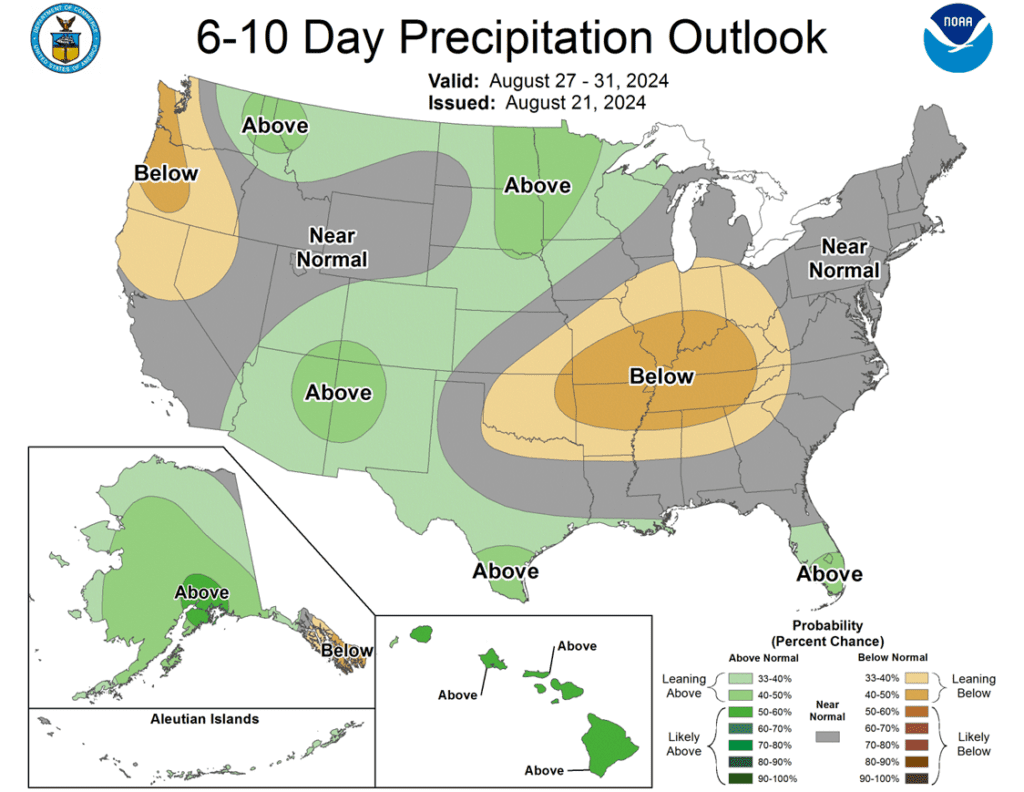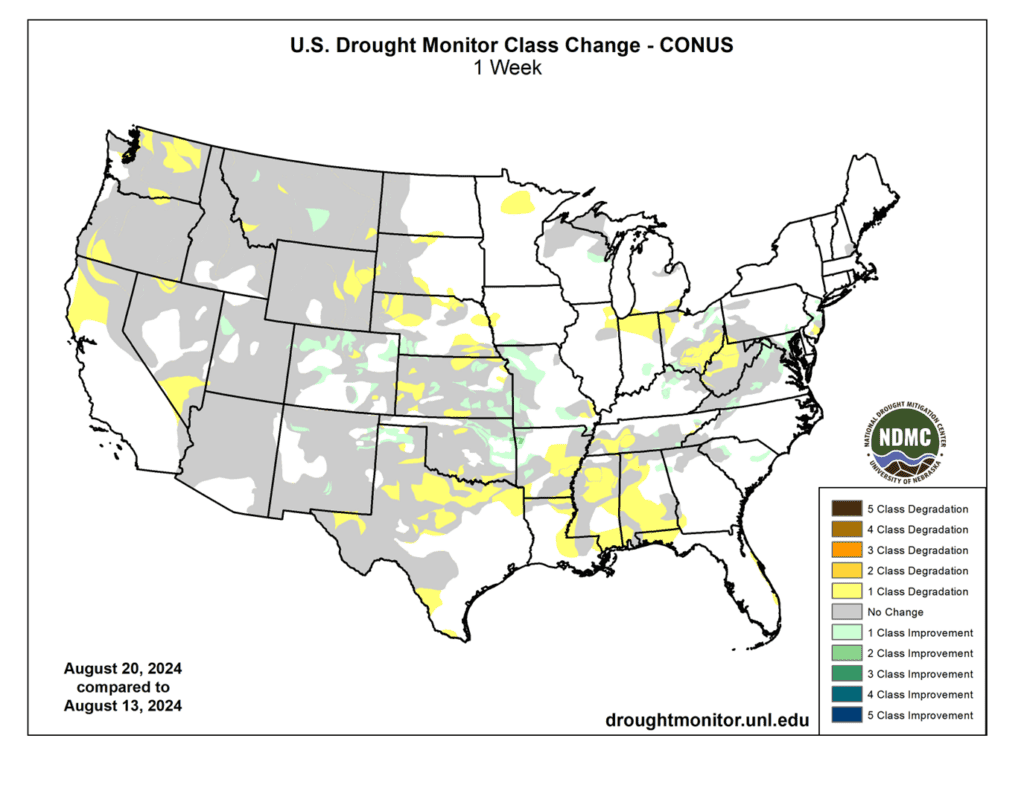8-22 End of Day: Wheat Follows Through on Weakness, as Corn and Beans Slide Despite Solid Export Sales
All prices as of 2:00 pm Central Time
| Corn | ||
| SEP ’24 | 371.5 | -4 |
| DEC ’24 | 393.5 | -4.75 |
| DEC ’25 | 432.75 | -4.25 |
| Soybeans | ||
| NOV ’24 | 961.5 | -20 |
| JAN ’25 | 979.5 | -20.25 |
| NOV ’25 | 1017 | -16.5 |
| Chicago Wheat | ||
| SEP ’24 | 511 | -8.75 |
| DEC ’24 | 535.5 | -8.5 |
| JUL ’25 | 574.25 | -8.5 |
| K.C. Wheat | ||
| SEP ’24 | 529.25 | -7 |
| DEC ’24 | 545 | -6.75 |
| JUL ’25 | 569.75 | -6.75 |
| Mpls Wheat | ||
| SEP ’24 | 568.25 | -13 |
| DEC ’24 | 584 | -13 |
| SEP ’25 | 631 | -7 |
| S&P 500 | ||
| SEP ’24 | 5599.75 | -41.75 |
| Crude Oil | ||
| OCT ’24 | 72.94 | 1.01 |
| Gold | ||
| OCT ’24 | 2496.4 | -27.7 |
Grain Market Highlights
- Sellers remained active in the corn market as pressure from lower wheat and sharply lower soybeans weighed on prices, despite fresh flash corn export sales to Mexico and unknown destinations. While weekly export sales came in above expectations, the overall slow sales pace remains a bearish factor.
- Despite weekly export sales coming in above expectations, total new crop commitments remain at multi-year lows. This combined with reports of record yield potential in Illinois put traders in sell mode across the soybean complex, with both soybean meal and oil following soybeans lower on the day.
- Another day of lower prices for Matif wheat, which hit fresh near-term lows; logistics issues with the shutdown of the two major Canadian railways, and a rebound in the US dollar, all combined to keep sellers active in the wheat complex. All three US classes of wheat closed lower today, led by the Minneapolis contracts.
- To see the updated US 5-day precipitation forecast, the 6 – 10 day Temperature and Precipitation Outlooks, and the current US Drought Monitor courtesy of NOAA, the Weather Prediction Center, and the NDMC, scroll down to the other Charts/Weather section.
Note – For the best viewing experience, some Grain Market Insider content is best viewed with your phone held horizontally.
Corn
Action Plan: Corn
Calls
2024
No New Action
2025
No New Action
2026
No New Action
Cash
2024
No New Action
2025
No New Action
2026
No New Action
Puts
2024
No New Action
2025
No New Action
2026
No New Action
Corn Action Plan Summary
Farmer selling of old crop bushels ahead of the upcoming harvest has kept pressure on corn futures over the last month. Nearly ideal weather conditions for most during the month of July and to start August have only added more pressure. The corn market’s ability to close higher following a record yield estimate of 183.1 bpa by the USDA is a good sign showing corn buyers are finding value at these multi-year low levels. Any unexpected downward shift in anticipated supply or increase in demand could trigger managed funds to cover some of their extensive short positions and rally prices, however, an extended rally is unlikely before combines start rolling.
- No new action is recommended for 2024 corn. In June we recommended buying Dec ’24 470 and 510 calls after Dec ’24 closed below 451, for their relative value and because we are at that time of year of high volatility when markets can move swiftly. Moving forward, our current strategy is to target the value of 29 cents to exit the Dec ’24 470 calls. Exiting the 470 calls at 29 cents will allow you to lock in gains in case prices fall back and hold the remaining 510 calls at or near a net neutral cost, which should continue to protect existing sales and give you confidence to make further sales if the market rallies sharply. Additionally, should a contra-seasonal rally occur considering the large net short managed fund position, we continue to target the 470 – 490 area to recommend making additional sales versus Dec ’24.
- No new action is currently recommended for 2025 corn. Between early June and late July Grain Market Insider made three separate sales recommendations to get early sales made for next year’s crop. Considering the seasonal weakness of the market in late summer and early fall, we will not be looking to post any targeted areas for new sales until late fall or early winter.
- No Action is currently recommended for 2026 corn. We currently aren’t considering any recommendations at this time for the 2026 crop that will be planted 2 years from now, and it may be some time before conditions are conducive to consider making any recommendations. Be patient as we monitor the markets for signs of improvement.
To date, Grain Market Insider has issued the following corn recommendations:

Market Notes: Corn
- The corn market succumbed to the path of least resistance and traded lower in sympathy with neighboring wheat and soybean markets. The prospect of solid yields this harvest, a sluggish export pace (though solid last week), and the continued movement of corn into the cash market remain bearish factors.
- Yesterday’s EIA data showed ethanol production rose to 1,100 thousand barrels per day (tbd) last week, up from 1,072 tbd the previous week and 5% higher than a year ago. Nearly 111 million bushels of corn were used, averaging 15.8 mb per day, exceeding the 14.7 mbd required to meet the USDA’s target.
- The USDA reported this morning that private exporters sold 110,490 mt of corn to Mexico and 132,000 mt to unknown destinations, both for delivery in the 24/25 marketing year.
- Today’s Export Sales report showed an increase of 4.7 mb in corn sales for 23/24 and a 50.8 mb rise for 24/25, slightly exceeding the average trade expectations. While weekly sales were strong, total new crop commitments remain sluggish, with only 14% of the USDA’s projection sold versus the 18% average for this time of year. Last week’s corn export shipments reached 45.5 mb, surpassing the 37.7 mb needed weekly to meet the USDA’s 23/24 export target of 2.250 billion bushels. The primary destinations were Mexico, Japan, and Colombia.
- The Pro Farmer crop tour published yield results for Illinois and western Iowa yesterday. Illinois showed a yield potential of 204.14 bpa, while western Iowa showed potential yields ranging between 176.6 bpa and 195.9 bpa. Overall, the numbers were above last year’s tour levels. The tour moved into southern Minnesota and central and eastern Iowa today.

Above: The gap higher on the continuous chart represents the 20-cent spread premium between the September contract and the (now represented) December contract. A rally above 412 could put the market on track to test the 425 – 430 resistance area. Whereas a break below 390 may put the market at risk of testing the 370 area.
Soybeans
Action Plan: Soybeans
Calls
2024
No New Action
2025
No New Action
2026
No New Action
Cash
2024
No New Action
2025
No New Action
2026
No New Action
Puts
2024
No New Action
2025
No New Action
2026
No New Action
Soybeans Action Plan Summary
Since late May, the soybean market has stair-stepped its way lower on sluggish new crop demand, good growing weather, and the prospect of a large upcoming crop, while weather forecasts remain mostly favorable to the crop, and the trade may be factoring in higher yield estimates. The USDA pegging US soybean yield at a record with a million harvested acre jump on the August WASDE broke the market even further. The funds have yet to see a reason to cover some of their extensive short positions ahead of the quickly approaching harvest.
- No new action is recommended for the 2024 crop. At the end of December, we recommended buying Nov ’24 1280 and 1360 calls due to the amount of uncertainty in the 2024 soybean crop and to give you confidence to make sales and protect those sales in an extended rally. Given that the market has retreated since that time, we are targeting the 1040 – 1070 range versus Nov ’24 futures to exit 1/3 of the 1280 calls to help preserve equity. Additionally in June, the close below 1180 triggered our Plan B strategy, which recommended making additional sales due to the potential change in trend. Should a bullish catalyst enter the market to turn prices higher, we are targeting the 1090 – 1120 range from our Plan A strategy to make additional sales recommendations.
- No Action is currently recommended for 2025 Soybeans. To date, Grain Market Insider has not recommended any sales for next year’s soybean crop yet. First sales targets will probably be set in late fall or early winter at the earliest. Currently, our focus is on watching for opportunities to recommend buying call options. Should Nov ‘25 reach the upper 1100 range, the likelihood of an extended rally would increase, and we would recommend buying upside call options at that time in preparation for that possibility.
- No Action is currently recommended for 2026 Soybeans. We currently aren’t considering any recommendations at this time for the 2026 crop that will be planted 2 years from now, and it may be some time before conditions are conducive to consider making any recommendations. Be patient as we monitor the markets for signs of improvement.
To date, Grain Market Insider has issued the following soybean recommendations:

Market Notes: Soybeans
- Soybeans ended the day significantly lower wiping out nearly all of the previous gains the November contract had made for the week as the Pro Farmer crop tour finds potentially big yields that could end up being record large. Improved chances of rain in the central Corn Belt have added pressure as well, and both soybean meal and oil ended the day lower as well.
- Today’s weekly Export Sales report saw a decrease of 1.6 mb of soybean export sales in 23/24 but an increase of 61.6 mb for 24/25, which was toward the higher end of trade estimates. Last week’s export shipments of 15.5 mb were below the 17.9 mb needed each week to meet the USDA’s export estimate of 1.700 bb. Primary destinations were to the Netherlands, Mexico, and Egypt.
- Domestic demand has been stout as well, with crush margins reportedly ranging from $2.10 to $2.60 per bushel in the Corn Belt which has given processors a large incentive to buy cash soybeans to crush. This should pair with the uptick in export demand recently, but trade is more focused on the large crop that will likely be harvested this fall.
- This morning, the USDA reported private export sales totaling 198,000 metric tons of soybeans for delivery to China during the 24/25 marketing year and 105,000 metric tons of soybean cake and meal for delivery to Vietnam for the 24/25 marketing year.

Above: The upward gap on the chart represents the 16-cent premium between the September and (now represented) November contract. Overhead resistance for November beans lies near 1000, with further resistance between 1016 and 1050. To the downside, a break below 950 puts the market at risk of sliding down to the 915 – 900 support area.
Wheat
Market Notes: Wheat
- Wheat closed lower, led by double-digit losses in spring wheat futures. Pressure stemmed from a sharp rebound in the US Dollar Index, as well as another down day and a new near-term low for Paris milling wheat futures.
- The USDA reported an increase of 18.1 mb of wheat export sales for 24/25. Shipments last week totaling 17.3 mb, exceeded the 16.0 mb pace needed per week to reach the USDA’s export goal of 825 mb. Wheat sales commitments have reached 346 mb for 24/25, up 31% from last year.
- The two largest railways in Canada shut down as a strike began last night. Canadian National Railway and Canadian Pacific Kansas City Ltd account for nearly 80% of Canada’s freight shipments. Additionally, BNSF railroad in Mexico suspended the issuance of new permits due to congestion. These rail issues are raising concerns about the logistics of grain movement, which added pressure to the grain complex today.
- Adding to bearishness in wheat is talk that the Chinese crop may be record-large at 138.2 mmt. As a net importer of wheat, this could reduce their need to import grain, which may pressure both US and global export markets.
- According to the USDA, as of August 20, approximately 21% of US spring wheat acres are experiencing drought. This is unchanged from the previous week, and conditions remain favorable in major producers North Dakota and Minnesota. However, drought in winter wheat areas has expanded 2% from last week to 45%, which may affect the establishment of the winter wheat crop that will soon be planted.
Action Plan: Chicago Wheat
Calls
2024
No New Action
2025
No New Action
2026
No New Action
Cash
2024
No New Action
2025
No New Action
2026
No New Action
Puts
2024
No New Action
2025
No New Action
2026
No New Action
Chicago Wheat Action Plan Summary
Since mid-July, the wheat market has mostly drifted sideways as the trade tries to balance smaller US and global supplies against cheaper world export prices. During this period, a potential seasonal low was also marked on July 29th as managed funds maintained a sizable net short position in Chicago wheat. While slow global import demand and low Russian export prices continue to exert pressure on the market, any increase in US demand due to smaller crops in Europe and the Black Sea region could trigger a short-covering rally by managed funds.
- No new action is recommended for 2024 Chicago wheat. Considering the recent rally in wheat, we recommended taking advantage of the elevated prices to make additional sales and buy upside July ’25 860 and 1020 calls (for their extended time frame) in case of a protracted rally. Our current strategy is to target 740 – 760 versus Sept ’24 to recommend further sales and to target a selling price of about 73 cents in the 860 calls to achieve a net neutral cost on the remaining 1020 calls. The remaining 1020 calls would then continue to protect existing sales and give you confidence to make additional sales at higher prices.
- No new action is currently recommended for 2025 Chicago Wheat. Our most recent recommendation was to exit half of the previously recommended July ’25 Chicago 620 puts once they reached 67 cents (approximately double their original cost), to lock in gains in case the market rallies back. Moving forward, our strategy is to hold the remaining July ’25 620 puts at, or near, a net neutral cost to maintain downside coverage for any unsold bushels, while also targeting the 610 – 630 range to recommend making additional sales.
- No action is currently recommended for 2026 Chicago Wheat. We currently aren’t considering any recommendations at this time for the 2026 crop that will be planted next year, and it may be some time before conditions are conducive to consider making any recommendations. Be patient as we monitor the markets for signs of improvement.
To date, Grain Market Insider has issued the following Chicago wheat recommendations:
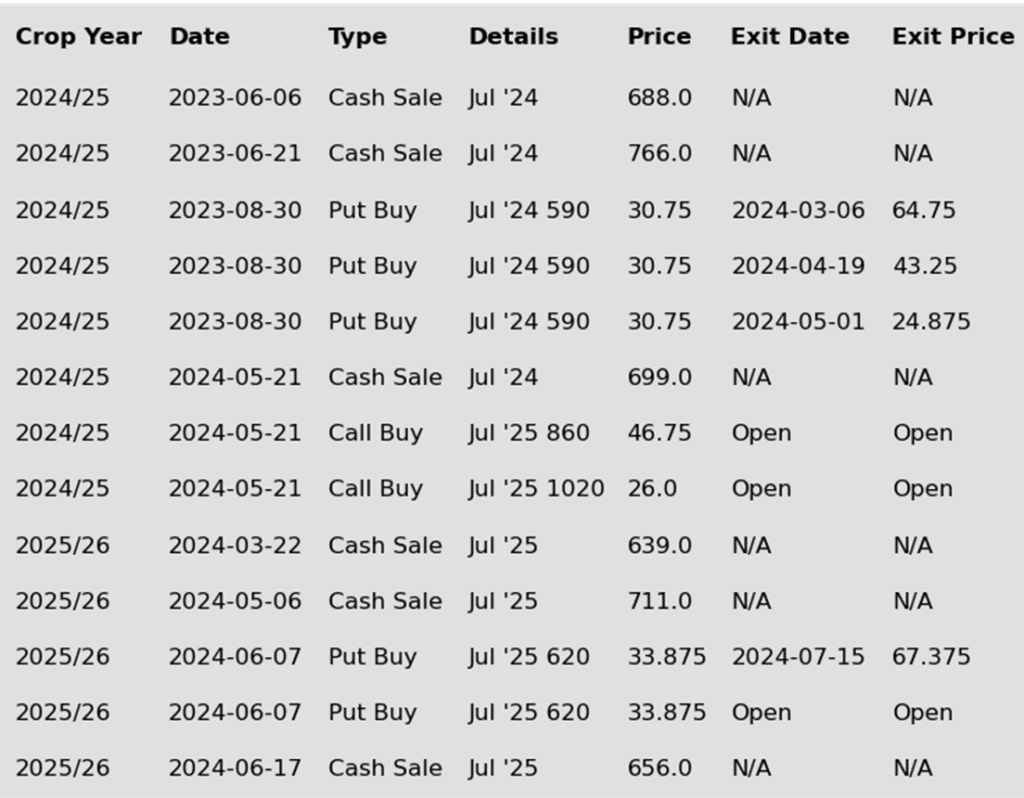

Above: Breaking the initial support at 537 puts December Chicago wheat at risk of dropping toward the July low of 514 ¼. However, the market may find support between 514 ¼ and 524, allowing it to stabilize. On the upside, resistance remains around the 50-day moving average; a rally above this level could push prices toward the 570–590 range.
Action Plan: KC Wheat
Calls
2024
No New Action
2025
No New Action
2026
No New Action
Cash
2024
No New Action
2025
No New Action
2026
No New Action
Puts
2024
No New Action
2025
No New Action
2026
No New Action
KC Wheat Action Plan Summary
Since mid-July, the wheat market has mostly drifted sideways as the trade tries to balance smaller US and global wheat supplies against cheaper world export prices. During this period, a potential seasonal low was also marked on the front month continuous charts as managed funds maintained a sizable net short position in the wheat markets. While low Black Sea export prices and slow world demand continue to weigh on US prices, the funds’ short position and oversold conditions could culminate in a short covering rally on any increase in US demand as world wheat ending stocks are expected to fall yet again this year.
- No new action is recommended for 2024 KC wheat. Considering the recent upside breakout in KC wheat, we recommended buying upside July ’25 860 and 1020 calls (for their extended time frame) in case of a protracted rally. Our current strategy is to target 725 – 750 versus Sept ’24 to recommend further sales and to target a selling price of about 71 cents on the 860 calls to achieve a net neutral cost on the remaining 1020 calls. The remaining 1020 calls would then continue to protect existing sales and give you confidence to make additional sales at higher prices.
- No new action is currently recommended for 2025 KC Wheat. We recently recommended exiting half of the previously recommended July ’25 620 puts once they reached 60 cents (double the original approximate cost) to realize gains in case the market rallies back, while still holding the remaining 620 puts at, or near, a net neutral cost for continued downside coverage on any unsold bushels. Looking ahead, our strategy is to target the 660 – 690 range to recommend making additional sales.
- No action is currently recommended for 2026 KC Wheat. We currently aren’t considering any recommendations at this time for the 2026 crop that will be planted next year, and it may be some time before conditions are conducive to consider making any recommendations. Be patient as we monitor the markets for signs of improvement.
To date, Grain Market Insider has issued the following KC recommendations:


Above: The upside gap on the chart represents the 15-cent premium between the September contract and the now represented December contract. Below the market, support lies around the 540 – 530 area. Overhead, initial resistance could be encountered around the 50-day moving average, and any rally above it could face additional resistance near 600.
Action Plan: Mpls Wheat
Calls
2024
No New Action
2025
No New Action
2026
No New Action
Cash
2024
No New Action
2025
No New Action
2026
No New Action
Puts
2024
No New Action
2025
No New Action
2026
No New Action
Mpls Wheat Action Plan Summary
Since printing a near-term low in mid-July, Minneapolis wheat has trended mostly sideways as the market attempts to balance smaller US and world supplies versus lower world export prices and lower world demand. During this period, managed funds have maintained their sizable, short positions in Minneapolis wheat. Though low Russian export prices continue to keep a lid on US prices, smaller crops in Europe and the Black Sea region could increase US demand, potentially triggering a short-covering rally, especially as global wheat ending stocks are projected to decline again this year.
- No new action is recommended for 2024 Minneapolis wheat. With the recent close below the 712 support level, Grain Market Insider implemented its Plan B stop strategy, recommending additional sales for the 2024 crop due to waning upside momentum and an increased likelihood of a downward trend. Given the heightened volatility and the amount of time that remains to market this crop, we will maintain the current July ’25 KC wheat 860 and 1020 call options. Our target is a selling price of about 71 cents for the 860 calls to achieve a net neutral cost on the remaining 1020 calls. These 1020 calls will continue to protect existing sales and provide confidence to make additional sales at higher prices.
- No new action is currently recommended for the 2025 Minneapolis wheat crop. Since the growing season can often yield some of the best sales opportunities, we recently made two separate sales recommendations to get some early sales on the books for next year’s crop. While we will not be targeting any specific areas to make additional sales until later in the marketing year, we will continue to monitor the market for opportunities to exit the remaining July ’25 KC 620 puts that were recommended in June. To that end, should the market continue to be weak, we are currently targeting the upper 400 range to exit half of those remaining puts.
- No Action is currently recommended for the 2026 Minneapolis wheat crop. We currently aren’t considering any recommendations at this time for the 2026 crop that will be planted 2 years from now, and it may be some time before conditions are conducive to consider making any recommendations. Be patient as we monitor the markets for signs of improvement.
To date, Grain Market Insider has issued the following Minneapolis wheat recommendations:


Above: The breach of the 595 support level puts the market at risk of trading lower. Support below the market now could be found between 579 and 575, with the next level of major support near 540. Overhead resistance remains near the 50-day moving average and then in the 617 – 637 area.
Other Charts / Weather
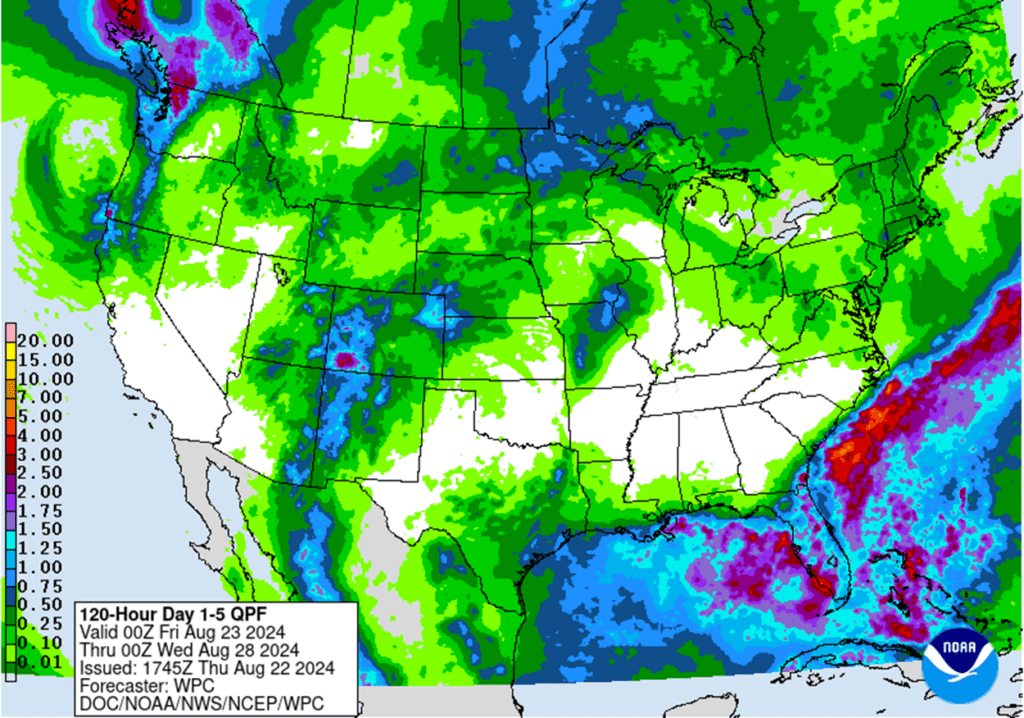
5-day precipitation forecast courtesy of NOAA, Weather Prediction Center.
